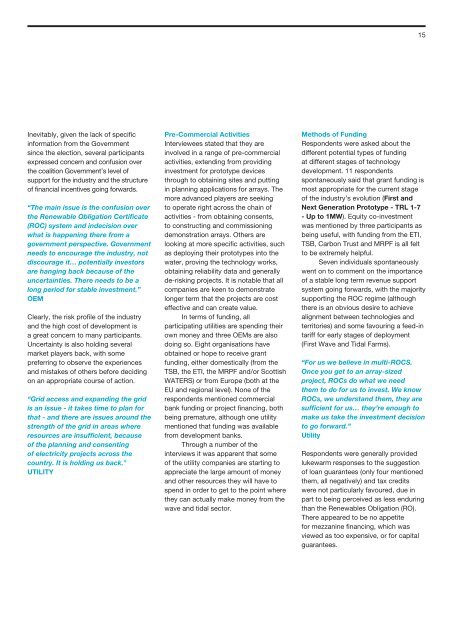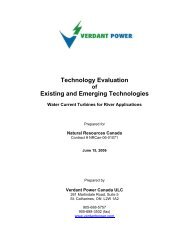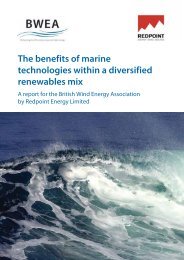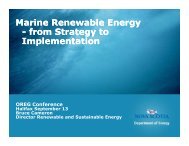Channeling the Energy - Marine Renewables Canada
Channeling the Energy - Marine Renewables Canada
Channeling the Energy - Marine Renewables Canada
Create successful ePaper yourself
Turn your PDF publications into a flip-book with our unique Google optimized e-Paper software.
15<br />
Inevitably, given <strong>the</strong> lack of specific<br />
information from <strong>the</strong> Government<br />
since <strong>the</strong> election, several participants<br />
expressed concern and confusion over<br />
<strong>the</strong> coalition Government’s level of<br />
support for <strong>the</strong> industry and <strong>the</strong> structure<br />
of financial incentives going forwards.<br />
“The main issue is <strong>the</strong> confusion over<br />
<strong>the</strong> Renewable Obligation Certificate<br />
(ROC) system and indecision over<br />
what is happening <strong>the</strong>re from a<br />
government perspective. Government<br />
needs to encourage <strong>the</strong> industry, not<br />
discourage it… potentially investors<br />
are hanging back because of <strong>the</strong><br />
uncertainties. There needs to be a<br />
long period for stable investment.”<br />
OEM<br />
Clearly, <strong>the</strong> risk profile of <strong>the</strong> industry<br />
and <strong>the</strong> high cost of development is<br />
a great concern to many participants.<br />
Uncertainty is also holding several<br />
market players back, with some<br />
preferring to observe <strong>the</strong> experiences<br />
and mistakes of o<strong>the</strong>rs before deciding<br />
on an appropriate course of action.<br />
“Grid access and expanding <strong>the</strong> grid<br />
is an issue - it takes time to plan for<br />
that - and <strong>the</strong>re are issues around <strong>the</strong><br />
strength of <strong>the</strong> grid in areas where<br />
resources are insufficient, because<br />
of <strong>the</strong> planning and consenting<br />
of electricity projects across <strong>the</strong><br />
country. It is holding us back.”<br />
UTILITY<br />
Pre-Commercial Activities<br />
Interviewees stated that <strong>the</strong>y are<br />
involved in a range of pre-commercial<br />
activities, extending from providing<br />
investment for prototype devices<br />
through to obtaining sites and putting<br />
in planning applications for arrays. The<br />
more advanced players are seeking<br />
to operate right across <strong>the</strong> chain of<br />
activities - from obtaining consents,<br />
to constructing and commissioning<br />
demonstration arrays. O<strong>the</strong>rs are<br />
looking at more specific activities, such<br />
as deploying <strong>the</strong>ir prototypes into <strong>the</strong><br />
water, proving <strong>the</strong> technology works,<br />
obtaining reliability data and generally<br />
de-risking projects. It is notable that all<br />
companies are keen to demonstrate<br />
longer term that <strong>the</strong> projects are cost<br />
effective and can create value.<br />
In terms of funding, all<br />
participating utilities are spending <strong>the</strong>ir<br />
own money and three OEMs are also<br />
doing so. Eight organisations have<br />
obtained or hope to receive grant<br />
funding, ei<strong>the</strong>r domestically (from <strong>the</strong><br />
TSB, <strong>the</strong> ETI, <strong>the</strong> MRPF and/or Scottish<br />
WATERS) or from Europe (both at <strong>the</strong><br />
EU and regional level). None of <strong>the</strong><br />
respondents mentioned commercial<br />
bank funding or project financing, both<br />
being premature, although one utility<br />
mentioned that funding was available<br />
from development banks.<br />
Through a number of <strong>the</strong><br />
interviews it was apparent that some<br />
of <strong>the</strong> utility companies are starting to<br />
appreciate <strong>the</strong> large amount of money<br />
and o<strong>the</strong>r resources <strong>the</strong>y will have to<br />
spend in order to get to <strong>the</strong> point where<br />
<strong>the</strong>y can actually make money from <strong>the</strong><br />
wave and tidal sector.<br />
Methods of Funding<br />
Respondents were asked about <strong>the</strong><br />
different potential types of funding<br />
at different stages of technology<br />
development. 11 respondents<br />
spontaneously said that grant funding is<br />
most appropriate for <strong>the</strong> current stage<br />
of <strong>the</strong> industry’s evolution (First and<br />
Next Generation Prototype - TRL 1-7<br />
- Up to 1MW). Equity co-investment<br />
was mentioned by three participants as<br />
being useful, with funding from <strong>the</strong> ETI,<br />
TSB, Carbon Trust and MRPF is all felt<br />
to be extremely helpful.<br />
Seven individuals spontaneously<br />
went on to comment on <strong>the</strong> importance<br />
of a stable long term revenue support<br />
system going forwards, with <strong>the</strong> majority<br />
supporting <strong>the</strong> ROC regime (although<br />
<strong>the</strong>re is an obvious desire to achieve<br />
alignment between technologies and<br />
territories) and some favouring a feed-in<br />
tariff for early stages of deployment<br />
(First Wave and Tidal Farms).<br />
“For us we believe in multi-ROCS.<br />
Once you get to an array-sized<br />
project, ROCs do what we need<br />
<strong>the</strong>m to do for us to invest. We know<br />
ROCs, we understand <strong>the</strong>m, <strong>the</strong>y are<br />
sufficient for us… <strong>the</strong>y’re enough to<br />
make us take <strong>the</strong> investment decision<br />
to go forward.”<br />
Utility<br />
Respondents were generally provided<br />
lukewarm responses to <strong>the</strong> suggestion<br />
of loan guarantees (only four mentioned<br />
<strong>the</strong>m, all negatively) and tax credits<br />
were not particularly favoured, due in<br />
part to being perceived as less enduring<br />
than <strong>the</strong> <strong>Renewables</strong> Obligation (RO).<br />
There appeared to be no appetite<br />
for mezzanine financing, which was<br />
viewed as too expensive, or for capital<br />
guarantees.










